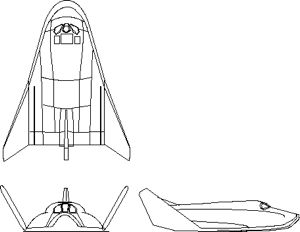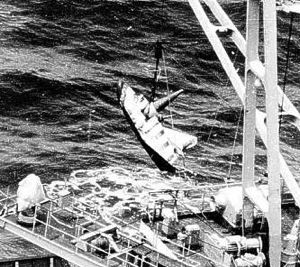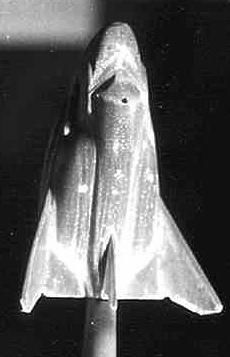
Home - Search - Browse - Alphabetic Index: 0- 1- 2- 3- 4- 5- 6- 7- 8- 9
A- B- C- D- E- F- G- H- I- J- K- L- M- N- O- P- Q- R- S- T- U- V- W- X- Y- Z
BOR-4
 BOR-4 in the shop BOR-4 in the shop prior to launch Credit: from Semenov, et. al., Buran, 1995. |
Status: Operational 1982. First Launch: 1982-06-03. Last Launch: 1984-12-19. Number: 4 . Gross mass: 1,200 kg (2,600 lb). Height: 2.80 m (9.10 ft).
After cancellation of Spiral, they were flown to test heat shield materials developed for Buran. After a circuit of the earth, the spacecraft would deorbit, perform a gliding re-entry, followed by parachute deployment, splashdown in the ocean, and recovery by Soviet naval forces.
In 1973 the VPK initiated the BOR program to accomplish research on a space glider. In order to investigate the hypersonic aerodynamic characteristics and heat shield materials of the manned Spiral OS lifting body, 1:3 and 1:2 scale models of the OS were to be built. Unlike the full-scale model, these were had fixed wings and were designated BOR (unpiloted orbital rocketplane). BOR-1, -2, and -3 were increasingly sophisticated models of the configuration, flown on suborbital trajectories. After the cancellation of Spiral in favor of the Buran, BOR-4 subscale spaceplanes were used to test heat shield materials developed for Buran. Certain essential tests of these heat shield materials could not be done in the lab. These included interaction with the plasma sheath during re-entry, chemical disassociation effects, etc. The BOR-4 was clad in 118 tiles of the type developed for Buran as well as carbon-carbon nose cap and leading edge. These BOR-4 unmanned orbiters were equipped with braking engines. After a circuit of the earth, the spacecraft would deorbit, perform a gliding re-entry, followed by parachute deployment, splashdown in the ocean, and recovery by Soviet naval forces. BOR-4 flew four successful test flights at speeds of from Mach 3 to 25 and altitudes of 30 to 100 km. These test flights confirmed the physical, chemical, and catalytic processes that operated on the selected heat shield materials in the re-entry plasma. BOR-4 also provided important data on the acoustic environment during launch and re-entry. Compared to the Spiral MiG 105-11 EPOS configuration, the BOR-4 had a flattened, wider body with a much smaller vertical stabilizer. The cruise-back turbojet of the 105-11 seems to have been eliminated, and the canted stabilizer tips were cut off at the Mach angle, a MiG trademark.
More at: BOR-4.
Family: Spaceplane. Country: Russia. Launch Vehicles: R-14, Kosmos 3, K65M-RB, Kosmos 65MP. Launch Sites: Kapustin Yar, Kapustin Yar LC107/1. Agency: MO, Molniya bureau. Bibliography: 189, 2, 6, 81, 83, 6396, 12159.
 | BOR-4 at Berlin BOR-4 as exhibited at Berlin side view Credit: Oliver Haßa |
 | BOR-4 Credit: Manufacturer Image |
 | BOR-4 at Berlin BOR-4 as exhibited at Berlin side view Credit: Oliver Haßa |
 | Uragan / BOR-4 Credit: © Mark Wade |
 | BOR-4 Recovery BOR-4 - Photo by Australian P-3 Naval Reconnaissance Aircraft Credit: NASA |
 | BOR-4 Recovery BOR-4 - Photo by Australian P-3 Naval Reconnaissance Aircraft Credit: NASA |
 | BOR-4 Model BOR-4 wind tunnel model used by NASA to study configuration and refine it for use in HL-20/HL-42 vehicles. Credit: NASA |
1982 June 3 - . 21:30 GMT - . Launch Site: Kapustin Yar. Launch Complex: Kapustin Yar LC107/1. Launch Pad: LC107/pad?. LV Family: R-14. Launch Vehicle: K65M-RB.
- Cosmos 1374 - .
Mass: 1,000 kg (2,200 lb). Nation: Russia.
Agency: MO.
Program: Buran.
Class: Manned.
Type: Manned spaceplane. Spacecraft Bus: Spiral 50-50.
Spacecraft: BOR-4.
Duration: 0.0700 days. Decay Date: 1982-06-03 . USAF Sat Cat: 13257 . COSPAR: 1982-054A. Apogee: 204 km (126 mi). Perigee: 158 km (98 mi). Inclination: 50.70 deg. Period: 88.10 min.
Subscale Spiral spaceplane. After 1.25 revolutions of the earth, deorbited and recovered by Soviet naval forces in the Indian Ocean at 17 degrees South, 98 degrees East, 560 km south of Cocos Islands. Made a 600 km cross-range maneuver during reentry. The recovery was filmed by an Australian Orion reconnaissance aircraft, revealing the configuration to the West for the first time.
1983 During the Year - .
- NASA Langley begins studies leading to HL-20 - .
Nation: USA.
Spacecraft: BOR-4,
HL-20.
The Vehicle Analysis Branch began investigation of the Soviet BOR-4. Small models were tested in NASA wind tunnels and demonstrated that the vehicle had good aerodynamic characteristics throughout the speed range from orbital entry interface to low supersonic speeds. The Soviet design had a 2,040 km cross-range capability and an outstandingly benign thermal profile at peak heating conditions. Therefore Langley adopted it as a baseline for a Crew Emergency Rescue Vehicle to back-up or replace the shuttle after the 1986 Challenger accident.
1983 March 15 - . 22:30 GMT - . Launch Site: Kapustin Yar. Launch Complex: Kapustin Yar LC107/1. Launch Pad: LC107/pad?. LV Family: R-14. Launch Vehicle: K65M-RB.
- Cosmos 1445 - . Mass: 1,000 kg (2,200 lb). Nation: Russia. Agency: MO. Program: Buran. Class: Manned. Type: Manned spaceplane. Spacecraft Bus: Spiral 50-50. Spacecraft: BOR-4. Duration: 0.0700 days. Decay Date: 1983-03-16 . USAF Sat Cat: 13883 . COSPAR: 1983-017A. Apogee: 208 km (129 mi). Perigee: 158 km (98 mi). Inclination: 50.70 deg. Period: 88.20 min. Subscale Spiral spaceplane. After 1.25 revolutions of the earth, deorbited and recovered by Soviet naval forces in the Indian Ocean, 556 km south of the Cocos Islands ..
1983 December 27 - . 10:00 GMT - . Launch Site: Kapustin Yar. Launch Complex: Kapustin Yar LC107/1. Launch Pad: LC107/pad?. LV Family: R-14. Launch Vehicle: K65M-RB.
- Cosmos 1517 - . Mass: 1,000 kg (2,200 lb). Nation: Russia. Agency: MO. Program: Buran. Class: Manned. Type: Manned spaceplane. Spacecraft Bus: Spiral 50-50. Spacecraft: BOR-4. Duration: 0.0500 days. Decay Date: 1983-12-27 . USAF Sat Cat: 14585 . COSPAR: 1983-125A. Apogee: 217 km (134 mi). Perigee: 212 km (131 mi). Inclination: 50.70 deg. Period: 88.80 min. Subscale Spiral spaceplane. In a new mission profile, braked out of orbit over the South Atlantic and was recovered in the Black Sea after one orbit of the Earth..
1984 December 19 - . 03:55 GMT - . Launch Site: Kapustin Yar. Launch Complex: Kapustin Yar LC107/1. Launch Pad: LC107/pad?. LV Family: R-14. Launch Vehicle: K65M-RB.
- Cosmos 1614 - . Mass: 1,000 kg (2,200 lb). Nation: Russia. Agency: MO. Program: Buran. Class: Manned. Type: Manned spaceplane. Spacecraft Bus: Spiral 50-50. Spacecraft: BOR-4. Duration: 0.0500 days. Decay Date: 1984-12-19 . USAF Sat Cat: 15442 . COSPAR: 1984-126A. Apogee: 223 km (138 mi). Perigee: 174 km (108 mi). Inclination: 50.70 deg. Period: 88.50 min. Last flight of the subscale Spiral spaceplane. Recovered December 19, 1984 5:26 GMT, in the Black Sea after one orbit of the Earth..
Back to top of page
Home - Search - Browse - Alphabetic Index: 0- 1- 2- 3- 4- 5- 6- 7- 8- 9
A- B- C- D- E- F- G- H- I- J- K- L- M- N- O- P- Q- R- S- T- U- V- W- X- Y- Z
© 1997-2019 Mark Wade - Contact
© / Conditions for Use